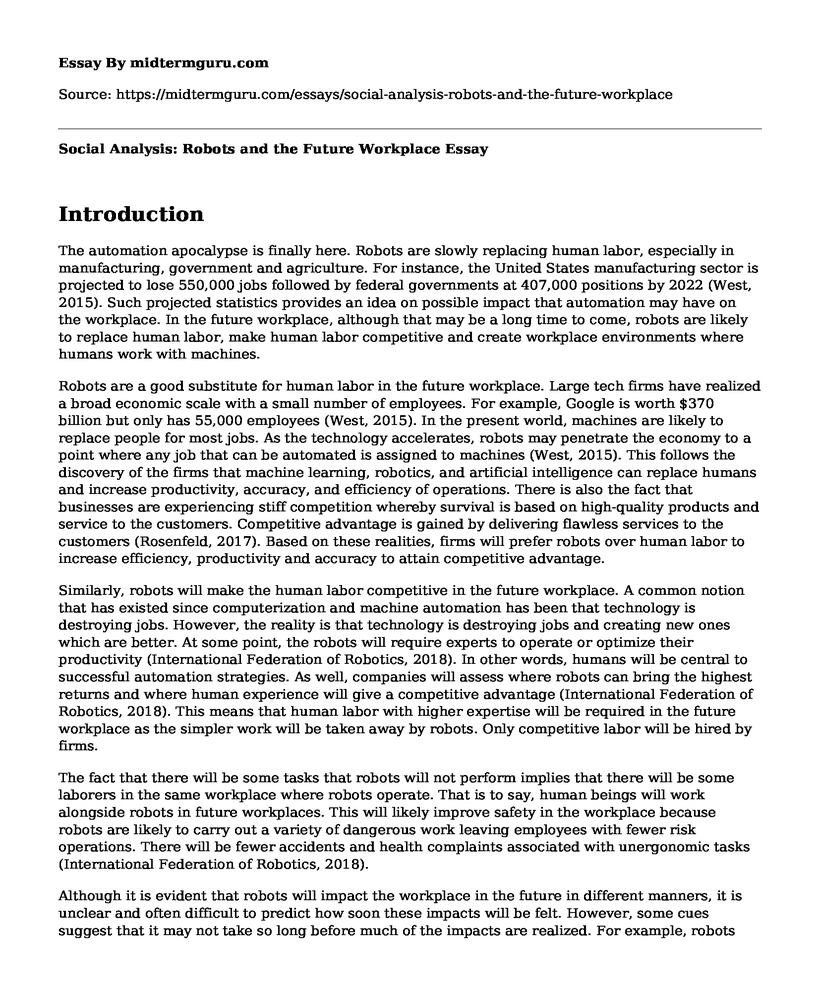Introduction
The automation apocalypse is finally here. Robots are slowly replacing human labor, especially in manufacturing, government and agriculture. For instance, the United States manufacturing sector is projected to lose 550,000 jobs followed by federal governments at 407,000 positions by 2022 (West, 2015). Such projected statistics provides an idea on possible impact that automation may have on the workplace. In the future workplace, although that may be a long time to come, robots are likely to replace human labor, make human labor competitive and create workplace environments where humans work with machines.
Robots are a good substitute for human labor in the future workplace. Large tech firms have realized a broad economic scale with a small number of employees. For example, Google is worth $370 billion but only has 55,000 employees (West, 2015). In the present world, machines are likely to replace people for most jobs. As the technology accelerates, robots may penetrate the economy to a point where any job that can be automated is assigned to machines (West, 2015). This follows the discovery of the firms that machine learning, robotics, and artificial intelligence can replace humans and increase productivity, accuracy, and efficiency of operations. There is also the fact that businesses are experiencing stiff competition whereby survival is based on high-quality products and service to the customers. Competitive advantage is gained by delivering flawless services to the customers (Rosenfeld, 2017). Based on these realities, firms will prefer robots over human labor to increase efficiency, productivity and accuracy to attain competitive advantage.
Similarly, robots will make the human labor competitive in the future workplace. A common notion that has existed since computerization and machine automation has been that technology is destroying jobs. However, the reality is that technology is destroying jobs and creating new ones which are better. At some point, the robots will require experts to operate or optimize their productivity (International Federation of Robotics, 2018). In other words, humans will be central to successful automation strategies. As well, companies will assess where robots can bring the highest returns and where human experience will give a competitive advantage (International Federation of Robotics, 2018). This means that human labor with higher expertise will be required in the future workplace as the simpler work will be taken away by robots. Only competitive labor will be hired by firms.
The fact that there will be some tasks that robots will not perform implies that there will be some laborers in the same workplace where robots operate. That is to say, human beings will work alongside robots in future workplaces. This will likely improve safety in the workplace because robots are likely to carry out a variety of dangerous work leaving employees with fewer risk operations. There will be fewer accidents and health complaints associated with unergonomic tasks (International Federation of Robotics, 2018).
Although it is evident that robots will impact the workplace in the future in different manners, it is unclear and often difficult to predict how soon these impacts will be felt. However, some cues suggest that it may not take so long before much of the impacts are realized. For example, robots are becoming cheaper by day, easy to repurpose and increasingly becoming easy to re-programme (International Federation of Robotics, 2018). The implication of this is that there would be a reduced cost of ownership of robots at a time when businesses are seeking for ways to improve their productivity, accuracy, and quality of service and products offered. This is likely to accelerate the rate of uptake of robots by small and large enterprises in the near future leading to transformed workplaces where human labor is substituted for intelligence machines as well as human labor integrated with robots in the same workplace.
References
International Federation of Robotics. (2018). Robots and the workplace of the future. Retrieved from https://ifr.org/downloads/papers/IFR_Robots_and_the_Workplace_of_the_Future_Positioning_Paper.pdf
Rosenfeld, S. A. (2017). Competitive manufacturing: New strategies for regional development. Routledge.
West, D. M. (2015). What happens if robots take the jobs? The impact of emerging technologies on employment and public policy. Centre for Technology Innovation at Brookings, Washington DC.
Cite this page
Social Analysis: Robots and the Future Workplace. (2022, Aug 29). Retrieved from https://midtermguru.com/essays/social-analysis-robots-and-the-future-workplace
If you are the original author of this essay and no longer wish to have it published on the midtermguru.com website, please click below to request its removal:
- The Importance of Turkey in Energy Hubs and Renewable Energy
- Essay Example on Atomic Energy
- Compare and Contrast Essay on Nuclear and Solar Energy
- Social Analysis: Robots and the Future Workplace
- New Phone: Urban Living Redefined With AI-Enabled Camera - Essay Sample
- Innovation: Key to Competing in High-Demand Markets - Research Paper
- Samsung: Error and OD Intervention - Essay Sample







